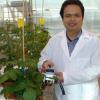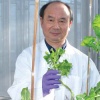Fredericton Research and Development Centre
The Fredericton Research and Development Centre (Fredericton RDC) was established in 1912 in Fredericton, New Brunswick. It is one of Agriculture and Agri-Food Canada's (AAFC) network of 20 research and development centres.
The Centre is associated with two satellite locations:
-
Main laboratory and office complex in Fredericton; and
-
Benton Ridge sub-station – which supports germplasm enhancement activities.
Areas of Research
The Fredericton RDC conducts research on potato cropping systems at all scales. One focus has research scientists collaborating on innovating to bring novel traits, new end uses, disease and pest resistance into potato germplasm using advanced technologies. The Centre’s Potato Breeding Team uses the germplasm to bring new varieties of potato to Canadian and international markets. Other teams look at the performance of crop production systems and how to incorporate a variety of crops, techniques and technologies into potato cropping systems which will grow yields and profits while improving and conserving soil and water, and reducing greenhouse gas emissions.
The Centre’s science also looks toward the threats to our production systems, to the new diseases and pests we can expect to challenge us as the climate changes and we assist our agricultural industries to be robust and resilient.
Search Research projects from the Fredericton Research and Development Centre to learn more about what we do.
Sector Needs
The Fredericton RDC carries out innovative research, development, technology and knowledge transfer activities in support of the AAFC's Strategic Plan for Science, which includes:
Develops potato germplasm for different production areas of Canada and coordinates with the Lethbridge Research and Development Centre to advance potato varieties for Western Canada. New varieties include traits for enhanced yield, environmental sustainability, health benefits, and use in bioproduct applications. Research is conducted to understand potato resistance to bacterial and viral pathogens and insect pests, and study the behavior to develop new ways to control potato diseases.
Research focuses on understanding nutrient dynamics and agro-chemical losses to the environment in potato production systems and developing technologies to predict nutrient deficiency. Fredericton RDC collaborates with AAFC’s Charlottetown Research and Development Centre to develop and evaluate beneficial management practices for enhanced efficiency and environmental sustainability of potato production.
The Plant Gene Resources Potato Collection collects, maintains and generates potato germplasm and their wild relatives. Scientists develop DNA fingerprinting and genotyping technologies to manage potato genetic resources and select core accessions for conservation, research and utilization.
Meet our Scientists
Find out more about the scientists at Fredericton Research and Development Centre through their profiles below.
You can also visit the Fields of Science campaign featuring 11 Agriculture and Agri-Food Canada scientists from coast to coast. Discover why they chose to pursue a career in agriculture and learn more about their research.

More information
Scientists and researchers


Publications
-
McKenzie-Gopsill A, Mills, Foster A, Wagg C. 2023. Choosing cover crops in Atlantic Canada. PEI Soil and Crop Improvement Association Annual General Meeting, Feb 8-9th 2023, Charlottetown PE Canada.
2023 - View publication details
-
Franklin, M.T., Wong, W., Uriel, Y., and S. Hann. 2023. Strawberry blossom weevil research update. Horticultural Growers' Short Course, Abbotsford, BC (oral presentation). January 26, 2023.
2023 - View publication details
-
Bizimungu, B. 2023. Biodiversity of bioactive compounds in potato- a member of the Solanaceae family. International Plant and Animal Genome-PAG30, January 13-18, 2023, San Diego, CA, USA (Abstract).
2023 - View publication details
-
McKenzie-Gopsill A, Mills A, Foster A, Wagg C. 2022. Choosing annual cover crops for Atlantic Canada. Atlantic Grains Council Annual General Meeting, Nov 23-24th 2022, Moncton NB Canada.
2022 - View publication details
-
MacDonald JL, Franklin M, Hann S. 2022. A more inclusive biovigilance approach to pest management: Case study of the strawberry blossom weevil. Joint Annual Meeting: Entomological Society of America, Entomological Society of Canada, Entomological Society of British Columbia. 6 Nov 2022. Vancouver, BC, Canada.
2022 - View publication details
-
Scott, I.M., J. Vickruck, S. Hann, S. Krolikowski, P. MacKinley, C. Moffat. 2022. Regional differences in susceptibility to spinosyn insecticides registered for Colorado potato beetle management. Recorded platform presentation for the American Chemical Society Fall 2022 Meeting, 2022 ACS International Award for Research in Agrochemicals: The Many Faces of Insecticide Toxicology: Resistance, Mode of Action, New Insecticides & Novel Control Strategies, Chicago IL, August 22, 2022.
2022 - View publication details
-
De Koeyer, D., B. Bizimungu, M. Antoun, L. Jewell, E. Fava, and R. Morgan. 2022. The use of genetic resistance to control potato wart caused by Synchytrium endobioticum – a Canadian perspective. Canadian Society of Horticultural Science Annual Meeting, August 19-20, 2022 Halifax, NS
2022 - View publication details
-
Potato greening: gaining an understanding through ‘omics approaches
K. Dougherty1, T. F. Mitterboeck1*, M. Lague1, M. Zaidi2, B. Bizimungu1, and B. Fofana2. 1Agriculture and Agri-Food Canada, Fredericton, New Brunswick, Canada E3B 4Z7 (e-mail:fatima.mitterboeck@agr.gc.ca); and 2Agriculture and Agri-Food Canada, Charlottetown, Prince Edward Island, Canada C1A 4N6.Potato ‘greening’ occurs when tubers are exposed to light, and results from a de novo synthesis of chlorophyll and a simultaneous formation of steroidal glycoalkaloids, which are toxic to humans and animals. Potato is the largest vegetable crop in Canada, and this greening causes substantial loss of products. Currently, there are no potato cultivars that are resistant to light–induced greening available on the market. The goal of this study is to understand the genetic components and molecular mechanisms of light-induced greening, and to use this knowledge to develop gene-editing tools to generate cultivars resistant to greening. From a core germplasm collection of over 800 mutant potato clones, two clones were observed to be tolerant to light-induced greening. These two non-greening clones, along with a greening control, underwent whole genome sequencing as well as transcriptomic sequencing after light exposure. Here, we will show our findings on single nucleotide polymorphisms (SNPs) and structural variants (SV) that differentiate the non-greening from greening clones. Deploying the non-greening trait into popular potato cultivars would be of high interest to the industry and stakeholders both for tuber appearance, quality, safety, marketability, and food waste reduction.
2022 - View publication details
-
Bizimungu, B. 20222. Genetic resources and their use to enhance the nutritional potential of potato. Canadian Society for Horticultural Science Annual Conference , Halifax 2022/08/18 - 2022/08/20 (Abstract).
2022 - View publication details
-
Fighting against potato greening
2022 - View publication details
Louis G. Sebarese LG1, Mohsin Zaidi1, Christian Lacroix2, Fatima Mitterboek3, Benoit Bizimungu3, and Bourlaye Fofana1
1Charlottetown Research and Development Centre, Agriculture and Agri-Food Canada, 440 University Avenue, Charlottetown, Prince Edward Island, C1A 4N6, Canada
2University of Prince Edward Island, 550 University Avenue, Charlottetown, Prince Edward Island, C1A 4P3, Canada
3Fredericton Research and Development Centre, Agriculture and Agri-Food Canada, Fredericton, New Brunswick, E3B 4Z7, Canada
Potato is the largest vegetable crop in Canada, with an export value of $1.8B in 2019. As a major food source, potato nutritional quality and safety are critical for the public health. Potato greening, also known as potato sunburn, causes 2-3% loss at the farm gate and up to 17% during postharvest and retail storage. It results from a de novo synthesis of chlorophyll in the cortical parenchyma cells under the periderm after light exposure and leads to a simultaneous formation of toxic steroidal glycoalkaloids (SGAs). Whereas chlorophyll itself is not a health hazard, SGAs are toxic to humans and animals. Development of potato cultivars that are resistant to light-induced greening is a viable strategy for an economic and environmental sustainability. We will present and discuss our approach and preliminary results towards an understanding of the tuber greening phenomenon in potato.
- ‹ previous
- 2 of 70
- next ›
















